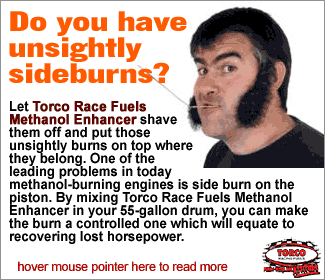| 
Let’s Level The Playing Field By Dumping
The “Television” Ladder
5/5/05
 hose
of you still faithfully following NHRA on cable must’ve
enjoyed the rare excitement of the Bristol race. The disappointment
of a crappy race track was outweighed, for me, by the many
fuel-car upsets that resulted. Unfortunately, all those shiny
new faces in the semis also reminded me how rare it’s
become for anyone outside of a mighty, multicar team to go
rounds. hose
of you still faithfully following NHRA on cable must’ve
enjoyed the rare excitement of the Bristol race. The disappointment
of a crappy race track was outweighed, for me, by the many
fuel-car upsets that resulted. Unfortunately, all those shiny
new faces in the semis also reminded me how rare it’s
become for anyone outside of a mighty, multicar team to go
rounds.
At most national events, we’ve all watched the old
excitement of qualifying and bumping degenerate into something
of a formality, if not a joke. All too often, underfunded
teams are forced to sit out one or more qualifying sessions
while the big boys jockey for position in a high-dollar hail
of fire and death smoke. Getting into the show is not the
challenge that it was in the past, particularly for the last-surviving
Top Fuel teams.
That’s as far you go, Joe! Alas, Sunday morning usually
sends the bottom half of the field off to slaughter. On a
better track than Bristol’s, what realistic chance does
even a great driver in a 16th-qualified, 4.80 car have against
a 4.40 car carrying some rich kid? As long as the current
elimination ladder remains in place, the only way your favorite
independent racer is likely to see the semi-finals is if his
well-funded opponent from the upper half of the field either
boils his balonies or burps his blower belt.
It
hasn’t always been this way, you know. Blame it all
on Larry Carrier — like NHRA did when Carrier’s
IHRA dared to defy drag racing’s traditional ladder
pairings (i.e., Number One meets Number Nine, and so on).
Equally critical of the change were low-buck racers and their
fans, for reasons that should be obvious to anyone reading
this magazine. Their
ADVERTISEMENT
 |
cries were drowned out by encouragement
from the sponsors, sponsored racers, track operators and advertisers
who stood to benefit from what some journalists derisively
dubbed the “television” ladder. In those early days of consistent TV exposure and —
not coincidentally — unprecedented series sponsorship
by Winston cigarettes, IHRA and NHRA event coverage started
with the second round of eliminations. Because the low qualifier
then drew the ninth qualifier (instead of Number 16), and
so on down the line, it wasn’t unusual for the quicker
qualifier to be upset in Round One by some local hotshot on
a holeshot. This possibility had always seemed like a good
thing for the sport, until television got involved. Instead
of flying their sponsors’ colors on the tube, some superstars
were on the trailer by the time the TV cameras rolled. This
was not a good thing for first-round losers and their backers,
nor for ratings (which traditionally drop off as the big names
disappear), nor for advertisers either on the screen or behind
the scenes; namely, R.J. Reynolds Tobacco.
The other, unspoken reason why promoters hated to see a superstar
taken out early — particularly by a little guy —
is the guaranteed appearance money and hotel rooms once promised
to popular racers. No matter where such a “bought-in”
racer finishes, he’s paid no less than the guarantee,
against his winnings.

|
